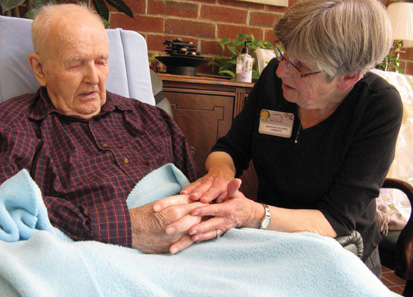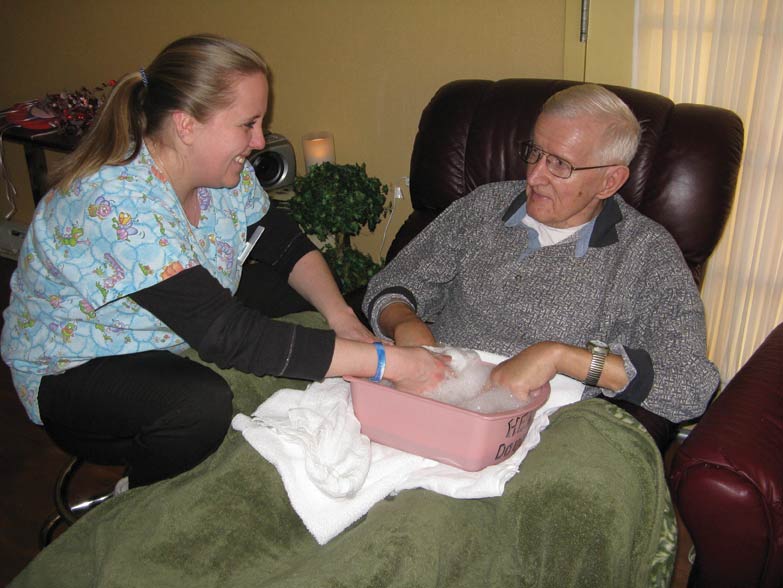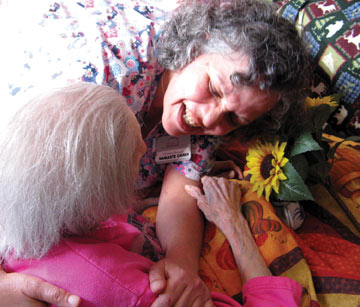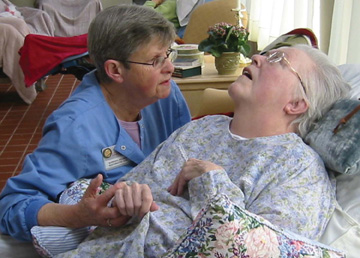
Traditional care offered in skilled nursing and assisted living facilities often fails to address the psychosocial and spiritual needs of residents in later stages of memory loss. Many residents with advanced-stage Alzheimer’s disease and related dementias cannot engage in a community’s daily activities like bingo, trivia, or sing-alongs. When not engaged in activities they may become agitated, depressed, apathetic, or withdrawn and are at an increased risk for falls.
A program called Namaste Care, implemented in eight EPOCH Senior Living communities in Massachusetts and Rhode Island, offers an innovative approach to care that places residents with advanced dementia in a soothing environment with meaningful activities designed specifically for them.
The term “namaste” comes from a Hindu statement that means “to honor the spirit within.” The program, which was first implemented six years ago, has been wildly successful and is surprisingly affordable. EPOCH’s management found it could address the needs of some of its most vulnerable residents and improve their quality of life without adding additional staff, purchasing expensive supplies, or setting aside a room exclusively for the program.
“From the beginning, it was a very moving experience,” says Joanna Cormac-Burt, EPOCH’s chief operating officer. “We had agitated residents who, once they were interacting with a caregiver in a peaceful room with nice chairs and soft music, calmed down. Participants become more engaged in small ways, instead of being lined up in wheelchairs in front of the nurse’s station, or sitting alone with a television.”
A Different Approach
EPOCH’s Namaste Care program provides a sense of structure and calm to residents who are unable to engage with the larger environment of their skilled nursing community. From the individualized greeting each participant receives at the start of a session to the peaceful environment where the program takes place, the individual resident is honored and cared for through a “loving touch” approach to activities of daily living.
In EPOCH communities, Namaste Care—introduced by Joyce Simard, MSW, a private geriatric consultant and EPOCH’s Alzheimer’s specialist—is offered seven days a week for six hours a day in a designated Namaste Care room.

The daily program begins after most residents have finished breakfast and are toileted and groomed. Residents in the Namaste Care program are taken to the Namaste Care room, which features soft lighting, cushy, comfortable lounge chairs, soothing music, and the calming scent of lavender.
Staff members greet residents according to their preferences. One resident goes by “Millie,” another prefers “Granny,” and a third might prefer the more formal “Dr. Powell.”
If a resident is in a wheelchair, she is placed in a comfortable lounge chair. Namaste Carers remove uncomfortable shoes, wrap a quilt around each resident, and check to make sure each resident is comfortable.
According to a recent study published in the American Journal of Alzheimer’s Disease and Other Dementias, each activity was offered in a slow, caring manner with the caregiver talking to the resident throughout the process.
The study, conducted by Simard and Ladislav Volicer, MD, describes how residents responded to facial cleansing and moisturizing. “The women seemed to react favorably to the scent of Ponds Cold Cream, a product many of them used when they were younger. The men responded in the same manner to the scent of Old Spice.”
The staff also offered residents in the program sips of liquid periodically. Since residents with advanced dementia rarely express thirst and take a long time to drink even small amounts of liquid, hydration is an integral part of the Namaste Care routine.
Namaste Carers have several items on hand that can help residents interact with their surroundings, such as realistic stuffed dogs and cats. The residents often happily engage with their “pet.” They talk to, cuddle with, and sleep peacefully with the stuffed animals.
Namaste Carers also provide clues about the seasons to bring pleasure to residents who rarely go outside. They use what nature provides: daffodils and tulips in the spring, roses and geraniums in the summer, pumpkins and colorful leaves in the fall, and snow or branches from fir trees in the winter.
Implementing The Program
Each EPOCH community that introduced Namaste Care faced unique challenges. Some buildings had no unused space for a room to be designated just for Namaste Care.
The pilot program, located in EPOCH’s community in Chestnut Hill, Mass., began in an empty room that had been a resident’s room. Simard and other staffers created a peaceful, homelike space using a bit of paint, some homelike curtains, a quilt hung over the call light system, used furniture, and a few pictures. As the program grew, staff moved the Namaste Care room to the former dining room, where as many as 20 residents could attend the program.

At EPOCH’s community in Norton, Mass., one of the first nursing facilities built in the state, the wing that cared for the majority of residents with advanced dementia had a single Day Room used for meals, activities, and family visits. Each day after breakfast, staff transformed the room. The Namaste Carer lowered the lights, started the soothing music, turned on the aroma diffuser, placed tablecloths on the round tables, and set china tea sets or centerpieces on some of the tables. When residents were taken back to the room, it felt like a different location.
At EPOCH’s community in Weston, Mass., Administrator Adam Goldman introduced Namaste Care even while the building underwent renovations and the construction of a new assisted living memory care wing. The program started in one room and moved three times before being settled in a permanent room, improving residents’ quality of life, despite the construction.
Namaste Care is surprisingly affordable. Communities already stock many of the supplies, such as nail clippers, basins, and emery boards. Face cloths and towels are provided by laundry, and beverages and snacks are available from food service. Namaste Care requires a few relatively inexpensive purchases, such as soft quilts, a compact disc (CD) player, CDs, lifelike stuffed animals, and an aroma diffuser. The largest expense is often a kitchen or tea cart on wheels that holds Namaste Care supplies.
Some communities also budgeted for comfortable recliners that many homes have in the television room. Most communities did not have money for lounge chairs and used padded geri-chairs. More recently, EPOCH has begun investing $5,000 to $10,000 on lounge chairs when it creates a Namaste Care room. “It could probably be done for less, but we wanted to use high-quality, longer-lasting chairs,” Cormac-Burt says.
EPOCH hired no additional staff members to launch Namaste Care, instead training one nurse assistant from each existing team and assigning them to the program.
EPOCH’s administrators eventually added a Namaste Care position to each community’s budget at an added cost of $23,000. Over time, many employees at EPOCH have come to view being assigned to the Namaste Care room as a promotion or sought-after assignment.
A Success Story
Namaste Care quickly became a key service offered by EPOCH. According to nurse reports, participants have fewer urinary tract infections and improved skin integrity, among other advancements.
“Sometimes we see a resident who is very agitated until we place them in Namaste Care, and their whole demeanor changes,” Cormac-Burt says. “This has happened again and again, which is why it’s so effective.”
Research now backs up this claim: The study found that residents attending Namaste Care for 60 days showed a decrease in the use of anti-anxiety medications, improved interest in their environment, and a decrease in indicators of delirium.

In addition, the minimum data set Challenging Behavior Profile was significantly decreased after enrollment in the Namaste program, indicating less impairment in social interaction.
“For residents who are withdrawn or have reduced social interaction, the study showed that participating in the program had decreased some indicators of delirium and decreased the need for administration of anti-anxiety medications,” according to the study.
Staff and family members find that residents are more verbal and aware of their environment. This is especially important to visiting family members.
“The Namaste program opened up a whole new way for my mom and me to communicate in a loving and safe environment,” Damon Grew Syphers, the son of one resident who attended Namaste Care until her death, wrote recently. “We had periods of time when we could touch, hug, and kiss. I sensed a peace and tranquility that I had not witnessed before in my mother. Mom felt loved and wanted.”
Joyce Simard, MSW, a private geriatric consultant and Alzheimer’s specialist at Waltham, Mass.-based EPOCH Senior Living and author of “The End-of-Life Namaste Care Program for People with Dementia,” can be reached at joycesimard@earthlink.net. Joanna Cormac-Burt, EPOCH’s chief operating officer, can be reached at joanna.cormac-burt@epochsl.com.